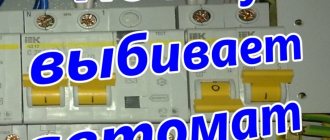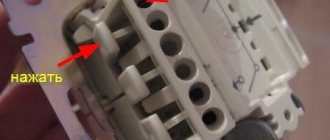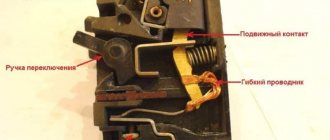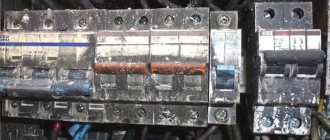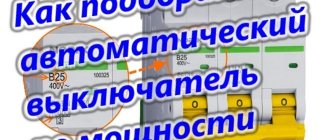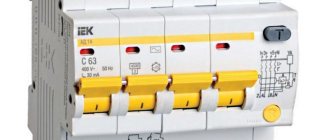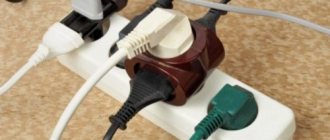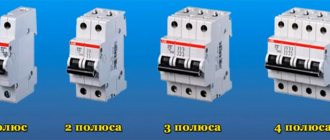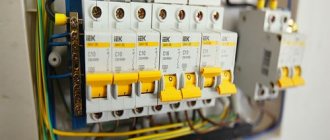On thematic forums, disputes periodically arise regarding the reasons that cause heating of conductors with zero potential when the phase wires of a household network are in normal condition. Despite numerous discussions on this issue, there are only three factors that can cause the negative impact in question:
- Low reliability of electrical contact.
- Influence of higher harmonics.
- Increased load to zero.
We propose to consider in detail each of the reasons listed above.
Low reliability of electrical contact
This reason is most typical for old wiring made of aluminum wires. The disadvantages of this material have been repeatedly described in other publications on our website, but it would not be amiss to briefly list them once again:
- The formation of an oxide film on the wire, which causes an increase in contact resistance.
- The plasticity of the material requires regular tightening of the joints.
- Overheating of aluminum wire increases its fragility.
Considering that attention is often paid to the electrical contacts of phase wires, the zero bus is often forgotten. As a result, the contact resistance increases over time, it heats up and sooner or later burns out. To be fair, it should be noted that this problem can also occur with copper wires. An example of poor contact with the zero bus in the apartment panel is shown in the photo.
Overheating of neutral wires due to poor contact
It is characteristic that the above problem most often manifests itself in residential panels, and not in electrical points. This is explained by the fact that the contact connections of the wires with the zero bus bear a greater load than a separate socket.
Influence of higher harmonics
With the advent of a large number of electrical appliances equipped with switching power supplies in everyday life and offices, a problem arose with overheating and, as a consequence, destruction (burnout) of the working zero wire. This occurs due to the latter being overloaded with higher harmonic currents. That is, a situation arises in which the zero carries more current than the phase conductors. In this case, the installation of protective devices is often carried out only on the latter.
In old systems, only linear loads were taken into account, in which only the fundamental harmonic was present (In the Soviet Union, and subsequently in the post-Soviet space, this was 50.0 Hz). In accordance with this, it was believed that the load on the phase wires would always be higher than on the working zero. This implied the impossibility of overloading zero more than a phase. Thus, protecting the phases from overheating also ensured zero safety.
With the advent of a large number of electrical consumers creating nonlinear loads, there is an increase in the current flowing through the working zero. This can lead to the latter burning out in old power systems. Examples of household electrical appliances causing nonlinearity:
- Microwave, induction and electric arc furnaces.
- LED and gas-discharge light sources.
- All devices with switching power supplies.
- Inverter electric machines, etc.
To prevent zero loss due to the influence of higher harmonics, changes were made to some regulatory documents. As an example, we can cite GOST 30804.4.30 2013, which requires that in calculations take into account harmonics whose order is from the 40th and higher. In GOST 50571.5.52 2011, it is recommended to select the cable cross-section depending on the most loaded current-carrying core, and the current load of the working zero should also be taken into account.
Unfortunately, the scope of the current article does not allow us to more fully explore the topic of higher harmonics, but we will definitely return to it in one of the subsequent publications on our website.
Increased load to zero
Sometimes you can hear that overheating of the zero wire is associated with increased load due to the connection of a neighbor to the PE bus for the purpose of stealing electricity. This option is interesting, but not feasible. In one of our publications, which described various designs of electric meters, their resistance to various methods of theft of electrical energy was considered. In particular, it discussed the option of using land as a working zero and explained why this method does not work on modern energy metering devices.
As mentioned above, in the neutral working wire the current can exceed the phase current only in cases of higher harmonics. Connecting a neighbor to zero (in your panel) will cause overheating of this wire if, as a result of such actions, poor contact is formed with the common bus.
Reasons for triggering the machine
Turning off the circuit breaker may be due to a short circuit or overload of the electrical wiring, a malfunction of the device itself or connected household appliances. The device can be turned on again, but before that it is important to determine why the machine was knocked out.
Network overload is the most common reason why a machine breaks down. This is an emergency operating mode in which the passing current is higher than the permissible calculated value. Most often, the situation happens when several devices are plugged into one outlet. For example, if the socket has two sockets and a washing machine and microwave are plugged into it at the same time. The load increases and the circuit breaker trips. Overload can also occur due to the fault of the supplier when voltage surges occur.
Household appliance malfunction
Breakdown of household appliances can also trigger the protective mechanism.
Pay attention to the time at which the machine turns off. If there is a certain pattern and the machine is triggered when a certain action is performed, most likely one of the electrical appliances is to blame. For example, if a power outage occurs while starting a washing machine, electric stove or boiler, turn them off and observe the behavior of the machine. If it does not turn off, look for a breakdown in these household appliances.
What should you not do if the machine turns off?
Unfortunately, people do not understand that a circuit breaker is primarily used for protection, and not just to turn on/off wiring during repairs. If the machine frequently trips, inexperienced electricians do not want to deal with the reasons for this behavior and simply suggest replacing it with a more powerful one.
| It is prohibited to replace the machine with a more powerful one. |
For example, if a 16-amp circuit breaker is installed in the switchboard, changing it to a 25-amp circuit breaker is prohibited. This will not end well, since due to high currents the protected electrical wiring itself may simply burn out.
We answered questions about why the machine knocks out. As you can see, the reasons for this are the same for a city apartment, a dacha and a country house. Moreover, the rules for our further actions are identical regardless of the location of the machine: the input and distribution panels or the panel on a pole.
If you understand the principles of operation of the machine, the malfunction can be eliminated yourself. If you don’t have the necessary confidence, then it’s best to call a technician who will quickly identify the location of the problem and carry out quality repairs.
The machines differ in the magnitude of the operating currents and are characterized by the ratio of the flowing current I to the rated current In.
The relative current values are plotted on the abscissa axis, and time is plotted on the ordinate axis. The figure shows the characteristics of the most common machines B and C.
Schematic diagram of the characteristics of the circuit breaker: a – circuit breaker B, b – circuit breaker C
If you choose a 10 A machine, then an increase in current by 3-5 times is considered a short circuit. When it increases to 50 A, the electromagnetic release will operate. In the figure, this will be the current, which corresponds to the value 5 on the x-axis. If you draw a vertical line from it until it intersects with the curve, and then a horizontal line until it intersects with the ordinate axis, you can find a response time of 0.01 seconds. When its magnitude is small, the short circuit has less of a destructive effect on the wiring.
When an overload of up to 15 A appears in the circuit, then I/In = 15/10 = 1.5. By drawing a vertical line from this point to the intersection with the curve, you can find the response time of 30 seconds. In this case, thermal protection works. If the wiring cross-section is selected correctly, its insulation will not melt during this time interval.
In Fig. b for machine C, the response time for a short circuit will be already 0.02 seconds.
The graphs display two curves, where the lower one characterizes the “hot state” of the machine, and the upper one characterizes the “cold state”. This is due to the fact that the operation of the machine depends on the ambient temperature. The lower it is, the longer it takes to warm up before triggering. These fluctuations are not so large and only play a role when the device operates at its nominal limit.
A correctly selected machine will not create false positives. After all, it can turn off even when starting the vacuum cleaner, which is extremely inconvenient for the apartment owner. The concept of “time-current characteristic” was introduced in order to select machines with the desired sensitivity. For this purpose, devices with the same power are divided into types, depending on different current and response time:
- A – thermal protection is triggered if In is exceeded by 1.3 times. Current protection operates at I > In 2 times at a speed of 0.05 sec. If the electromagnet does not work, the thermal protection will open the circuit, but not earlier than 20-30 seconds. This is how long it takes for the bimetallic plate to heat up before the network disconnects. Type A circuit breakers are used in electrical circuits containing semiconductor parts, which are destroyed by a slight increase in current.
- B - the solenoid turns off the circuit when the rating increases three times. The response time of the electromagnetic release during a short circuit is 0.015 sec. Thermal protection will work in 4-5 seconds. Type B is used for lighting circuits with low inrush currents.
- C is the most used type. Short circuit operation occurs when the current increases by 5 times. Used in lighting circuits and electrical appliances with moderate inrush current.
- D – type of circuit breaker is used for high starting currents (to protect electric motors and other active-inductive loads).
Some machines do not need overload protection. The load can be installed with a current relay and the circuit breaker is required as short-circuit protection. It is designated by the MA characteristic.
Connecting a circuit breaker to protect an electrical circuit
Any machine can pass through itself a current 1.13 times higher than the rated one. Therefore, the wiring should be taken with a reserve cross-section. In this case, the diameter of the cores should be measured before installation, since they can be manufactured to a minimum tolerance.
The response characteristics of protection devices at different stages of the network should not overlap. It is necessary to disconnect the load before any other circuit breaker located closer to the power circuit.
So, if the automatic plug is heating up, you must:
- check the contact connections in the plug itself;
- check the contact connections after the introductory machine;
- check the contact connections on the meter;
- check contact connections in junction boxes.
Plug on the meter
If all connections are tight, and the plug on the meter is working properly and still heats up, then you should take a special electrical clamp or tester. Next, measure the current in the wiring with electrical devices connected.
Permissible current values for copper conductors: cross section 1.5 mm2 - 19 amperes, cross section 2.5 mm2 - 27 amperes. Permissible current values for aluminum conductors: cross section 2.5 mm2 - 20 amperes, cross section 4 mm2 - 28 amperes.
Possible reasons for turning off the machine in the electrical panel
There are several sources of unstable operation of the machine. Some of them you can handle on your own, while others require calling a professional electrician.
High wiring load
Network overload is the main culprit for knocking out the machine. The bimetallic strip inside the device heats up, opening the contact. This happens when several powerful appliances (boiler, refrigerator, washing machine) are simultaneously connected to one electrical group, and their total power reaches 17-20 Amperes.
The machine is designed for a peak load of 16 Amps. The result of the simultaneous activation of a group of devices is that the circuit breaker trips, stopping the supply of electricity, maintaining the integrity of the electrical wiring.
There are four options to solve the problem:
install a more powerful machine, but there is a risk of ignition of the remaining old wiring: after all, the load remains the same and if the machine does not work, and the wires cannot withstand the greater load, then they may simply burn out;
avoid turning on several powerful devices at the same time;
distribute the power of the devices among different machines, but you will need to lay a new cable and install an additional socket;
replace the old wire with a new one of larger cross-section.
The last option is considered the most acceptable - it guarantees reliability and minimizes the risk of automatic shutdown in the future. The implementation of the plan is impossible without the help of a specialist.
Failure of a household appliance
The reason for shutting down the machine is the failure of used electrical appliances. It is necessary to determine which equipment is faulty. First, turn off household appliances that were turned on before the machine was knocked out.
Then connect one by one and observe which device the automation turns off the electricity again.
The machine can knock out when the refrigerator is turned on:
failed compressor;
malfunction of the start relay;
burnt-out heating element of the evaporation unit of the “No Frost” system.
When the machine on the meter is knocked out simultaneously with the start of the electric boiler, the root cause is the following malfunctions:
damage to heating elements: the coolant comes into contact with the coil located inside;
the power cable is broken;
There is a breakdown to the casing, which occurs when the internal wiring of the boiler is exposed.
Microwave ovens are characterized by the following problems that affect the operation of the circuit breaker:
defects in the operation of a transformer that converts voltage current from one type to another;
short circuit inside the magnetron.
Short circuit
A similar situation occurs when the phase wire is in contact with zero. The result is that the machine can knock out without load. This often happens after repair or installation work involving drilling holes in the walls where the cable is laid.
To prevent short circuits, it is necessary to inspect the areas that were affected during repairs. If damage to the wire is detected, it must be replaced with a new one.
Poor contact
If the automation starts to turn off without obvious reasons, the problem lies in the places where the wires are connected. The area of the flaw is easy to determine: not far from the shield itself or near room sockets. First, you need to double-check all the clamps in the switchboard near the meter, especially if the input machine is knocked out. Next we move on to distribution boxes, sockets, and switches.
If, after rechecking all connections, it continues to knock out, then the problem lies directly in the malfunction of the automatic device, it requires replacement.
from professionals
Have any electrical work done by a professional. We do it reliably, with a guarantee.
Other reasons for circuit breaker tripping
Knocking out can also be associated with a short-term increase in current when an incandescent light bulb burns out. There are especially frequent cases when the installed switch is designed for low power - up to 10 Amperes.
There are cases when the machine breaks down when the voltage stabilizer is turned on, which is due to the technical features of the latter. When they are turned on, a current is generated that exceeds the value of the existing circuit breaker. Remember that inexpensive stabilizers often fail, are unreliable, and therefore often break.
Despite the fact that at first glance it seems like the problem can be easily solved, repairs and replacements should only be carried out by a professional electrician. Otherwise, not only the electrical appliance may be damaged, but also all the wiring will ignite or melt.
provides comprehensive services for maintaining electrical networks in apartments and private houses. The craftsmen on our staff have the appropriate education and permits to perform electrical installation work, including high-voltage networks (more than 1000 V).
Our specialists
Our experienced electrical installation technicians are ready to perform any type of electrical work, electrical repairs, and replacement of wiring in apartments and houses. Complete electrical design documentation.
Why do the contacts of electrical connections get hot?
One of the “weak points” of any electrical wiring, including the electrical wiring of an apartment and a house, has always been the places where electrical wires are connected and the places where the wiring wires are connected to the contacts of installation products.
The concept of “weak point” of electrical wiring means the need to pay special attention to them when carrying out electrical work here. The use of low-quality products during electrical installation, products not intended for their intended purpose, or lack of skills in electrical installation work can lead to rapid failure of household appliances, as well as emergency situations.
Danger of current
Electric current, to which we are so accustomed that we don’t even think about it, is actually a very dangerous invention of mankind. Being invisible and intangible, electric current poses a mortal threat to humans and a potential danger to the home.
The danger of electric current occurs not only in serious emergency situations, such as a short circuit or exposure of live wiring elements. There is a hidden danger of current, which manifests itself in heating, overheating and further fire of electrical wiring sections, in particular at the places of connections and connections.
What are the dangers of poor connections and connections?
Poor contact of current-carrying wires when connecting to each other and at the points of connection to devices leads to heating of the contact points. Why do the contacts get hot?
The physics of heating of poorly made contacts is explained by a simple law of two physicists, Joule and Lorentz. Let me remind you:
The heat generated is proportional to the square of the current, the resistance of the conductor and the flow time.
With good contact between two metal wiring elements, the heat generated by the current has a very specific value, which is calculated and taken into account when choosing the cross-section of conductors and the ratings of circuit breakers.
When the contact is broken, at short distances of such a violation, or, more simply put, when the contact is weakened, the resistance begins to increase, more heat is released, and the contacts begin to heat up.
Professional servicing of cash register equipment
The heating of the contacts further enhances the thermal expansion of the connection points, as a result the contact weakens even more. As a result, the contact resistance tends to almost infinity (air specific resistance 1016), heating increases.
Added to the heating of the contacts is the sparking of the contacts, which is accompanied by a colossal release of heat. As a result, burnout of contacts, burning of installation products, or, as the most dangerous option, a fire in the house.
Causes of bad contacts
Let us highlight several reasons for poor contacts in electrical wiring.
- Incorrect wire connection.
- Operational loosening of screw terminals.
- Poor quality installation product.
- Violation of connection rules.
Incorrect conductor connection
We will talk about incorrect connection of conductors in the next article. Here I note that it is preferable to use special terminal blocks to connect two conductors.
Operational loosening of screw terminals
Over time, any screw clamp that is not tightened will weaken. For electrical wiring, the recommended period for tightening contacts in switchboards is 6-8 years (departmental instructions). The same period can be applied to the wiring of contacts in sockets and switches.
The use of devices and products with non-screw connections will help to avoid pulling screw contacts. The contacts of such devices are constantly pressed by a spring.
Poor quality installation product
Poor quality of the purchased socket, switch, or protective device may be the cause of poor connection contact.
Violation of connection rules
When connecting a socket, switch, circuit breaker, you must strictly follow the connection rules. For example:
- When connecting a cable of sockets, use wires of the same cross-section for the cable jumpers. This will prevent contact distortion;
- If you need to connect wires of different sections to a contact, make rings at the end of the wires to connect to the contact. Such a connection requires the purchase of installation products with no input;
- Do not connect more wires than specified in the instructions for the device. For example, look at the Legrand outlet. The design of the socket itself says that more than two wires cannot be connected to one contact (elderly input).
Air power supply to a wooden house
Particular attention should be paid to connecting circuit breakers and protection devices. More about this here, and briefly here. If you look at the contacts of machines made by different manufacturers, we will see that there are flat contacts (for example, IEK), and there are semicircular ones (for example, ABB). Also, two-pole and three-pole ABB circuit breakers have two contact groups, one for the comb, the second for the wire. What does this mean?
- According to the manufacturer's instructions, only one wire can be inserted into a circuit breaker with a semicircular contact.
- Either one or two wires can be inserted into a circuit breaker with direct contact.
- To connect machines with a cable, it is better to use connection combs.
- Contacts on circuit breakers and protective devices must be tightened with a load according to the manufacturers' instructions. Typically, 2.8 N/m.
